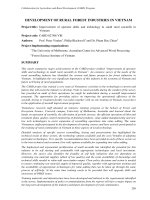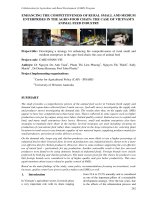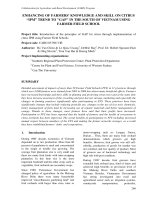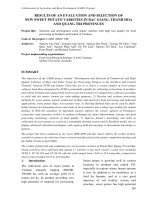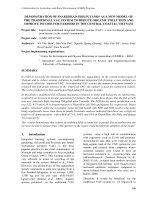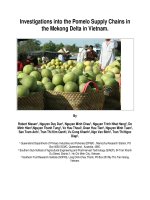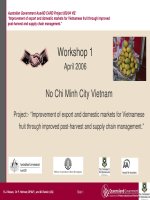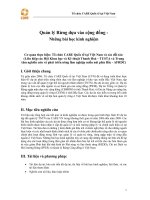Báo cáo nghiên cứu nông nghiệp "Investigations into the Pomelo Supply Chains in the Mekong Delta in Vietnam " ppt
Bạn đang xem bản rút gọn của tài liệu. Xem và tải ngay bản đầy đủ của tài liệu tại đây (1.16 MB, 63 trang )
Investigations into the Pomelo Supply Chains in
the Mekong Delta in Vietnam.
By
Robert Nissen
1
, Nguyen Duy Duc
2
, Nguyen Minh Chau
3
, Nguyen Trinh Nhat Hang
2
, Do
Minh Hien
3
,Nguyen Thanh Tung
3
, Vo Huu Thoai
3
, Doan Huu Tien
3
, Nguyen Minh Tuan
3
,
San Tram Anh
2
, Tran Thi Kim Oanh
2
,
Vu Cong Khanh
2
, Ngo Van Binh
2
, Tran Thi Ngoc
Diep
2
.
1
Queensland Department of Primary Industries and Fisheries (DPI&F) , Maroochy Research Station, PO
Box 5083 SCMC, Queensland, Australia, 4560.
2
Southern Sub-Institute of Agricultural Engineering and Post-Harvest Technology (SIAEP), 54 Tran Khanh
Du Street, District 1, Ho Chi Minh City, Vietnam.
3
Southern Fruit Research Institute (SOFRI), Long Dinh-Chau Thanh, P0 Box 203 My Tho Tien Giang,
Vietnam.
AusAID CARD Project 050/04 VIE Improvement of domestic and export markets through improved post harvest and supply chain management
January 2008 Page 2
© The State of Queensland, Department of Primary Industries and Fisheries 2008.
Copyright protects this work. Except as permitted by the Copyright Act 1968 (Cth), reproduction by any means (photocopying,
electronic, mechanical, recording or otherwise), making available online, electronic transmission or other publication of this
work is prohibited without the prior written permission of The Department of Primary Industries and Fisheries, Queensland.
Inquiries should be addressed to
(phone 61 7 3404 6999), or
Director,
Intellectual Property Commercialisation Unit
Department of Primary Industries and Fisheries
GPO Box 46
Brisbane Queensland 4001
All rights reserved. Reproduction and dissemination of materials in this information product for educational or other non
commercial purposes is authorised without any prior written permission from the copyright holders provided the sources is fully
acknowledged. Reproduction of materials in this information product for resale or other commercial purposes is prohibited
without written permission of the copyright holders.
AusAID CARD Project 050/04 VIE Improvement of domestic and export markets through improved post harvest and supply chain management
January 2008 Page 3
Table of Contents
Introduction 5
Methodology 5
Results 5
Overview and Background 5
World Production of Grapefruit and Pomelo 5
Pomelo:- Botanical description Error! Bookmark not defined.
Vietnam Country Overview 7
Pomelo Varieties of Vietnam 8
Pomelo Variety Nam Roi 8
Pomelo Variety Da Xanh 8
Pomelo Variety Long Hong 9
Pomelo:- Climatic Requirements 10
Pomelo Production in Vietnam 11
Pomelo Production (yield) 13
Consumers 18
Retailers 20
City Retailers (Ho Chi Minh & Hanoi) 20
Hawkers and Street Vendors 20
Supermarkets 20
Retailers (Fruit Shops) 21
Provincial Retailers 21
Local Retailers 21
Fruit Losses During Retailing 22
Retail Prices 22
Restaurants, Hotels and Tourists Resorts 23
Wholesalers 24
Collectors/Traders/Packing Agents 28
Collector 28
Traders/Enterprises (Companies) 29
Enterprises (Companies) 31
Local Packing Agents 31
Trader/Collectors/Packing Agent Transportation and Packaging Methods 32
Trader/Collectors/Packing Agent selling price 33
Farmers 34
Orchard Location and Size 34
Productivity and Yield 34
Orchard Establishment and Development 34
Orchard Management 34
Harvesting 35
Shelf life of pomelo fruit 35
Grading and sorting on farm 35
Grading: 36
Packaging 36
Farmer selling methods 37
Method 1. 38
AusAID CARD Project 050/04 VIE Improvement of domestic and export markets through improved post harvest and supply chain management
January 2008 Page 4
Method 2. 39
Method 3. 39
Economics and Market information (Price) 39
Pomelo Yearly Average Farm Gate Price in MRD 43
Comparison of the seasonal average farm gate price for 2006 for the pomelo variety Nam Roi between
the provinces of Tien Giang and Vinh Long province in MRD 43
Comparison of the seasonal average farm gate price for 2006 for the pomelo variety Da Xanh between
the provinces of Tien Giang and Vinh Long in MRD 44
Comparison of the seasonal average farm gate price for 2006 by variety in MRD 45
Comparison of pomelo farm gate price to wholesale and retail market prices 46
Supply/Value Chain ANalysis 47
Supply/Value Chain Channel 1 50
Supply/Value Chain Channel 2 51
Supply/Value Chain Channel 2 (a) 51
Supply/Value Chain Channel 2 (b) 51
Supply/Value Chain Channel 2 (c) 52
Supply/Value Chain Channel 3 52
Supply/Value Chain Channel 4 53
Discussion and Conclusions 55
References 57
AusAID CARD Project 050/04 VIE Improvement of domestic and export markets through improved post harvest and supply chain management
January 2008 Page 5
INTRODUCTION
This report provides baseline information on investigations undertaken as part of the Collaboration for
Agriculture and Rural Development CARD Project 050/04VIE “Improvement of export and domestic markets
for Vietnamese fruit through improved post-harvest and supply chain management”. This collaborative
project is funded by AusAID and administered by Hassall and Associates International. The project is
between the Queensland Department of Primary Industries and Fisheries (QDPI&F) and the Vietnamese
organisations, Southern Sub-Institute of Agricultural Engineering and Post-Harvest Technology (SIAEP),
and Southern Fruit Research Institute (SOFRI).
The aim of this report is to investigate and understand pomelo supply chains in Mekong Delta, Vietnam by:
• determining pre- and post-harvest technology practices of these supply chains
• determining the quality of the product produced by these supply chains
• identifying participants in the existing domestic and export supply chains
• map the existing mango supply chains and their and distribution channels
METHODOLOGY
Several methods were used to collect baseline data on pomelo supply chains operating in the Mekong Delta
of Vietnam. Relevant data and information was collected from the internet and reports produced by the
Ministry of Agriculture and Rural Development (MARD), The Government Statistics Office (GSO) of
Vietnam, and provincial government offices in the Mekong Delta, Vietnam. Further information was
obtained from the internet and published reports and databases of the Food and Agricultural Organisation
(FAO) of the United Nations, World Bank Vinh Long, DARD and Institute of Agricultural Planning &
Designing.
Survey sheets and process analyses were developed and tested by Vietnamese project staff. The supply
chain was segmented into the various supply chain participant groups; wholesalers, traders, farmers and
one company. Investigation was carried out via interviews and surveys with wholesalers, traders and
farmers along the pomelo supply chains operating in the Bin Minh District and Vinh Long Province, Cai Be
District, Tien Giang Province, in Vietnam in July 2005 to May in 2006.
Interviews were conducted with:
• 20 Nam Roi pomelo farmers at Binh Minh District and Vinh Long Province
• 9 Nam Roi pomelo traders at Binh Minh District and Vinh Long Province
• 4 Nam Roi pomelo wholesalers at Cai Be District, Tien Giang Province
• 1 Nam Roi pomelo exporting & processing Co. at Binh Minh District and Vinh Long Province.
RESULTS
OVERVIEW AND BACKGROUND
WORLD PRODUCTION OF GRAPEFRUIT AND POMELO
Pomelo belongs to Citrus maxima or Citrus grandis. Pomelo is a native to Southeast Asia and is widely
cultivated in Malaysia, China, Vietnam, India, Thailand, Indonesia and other Asian countries. Pomelo is the
AusAID CARD Project 050/04 VIE Improvement of domestic and export markets through improved post harvest and supply chain management
January 2008 Page 6
third largest fruit exported from Thailand and accounts for 11% of total fruit exported. FAO statistical data
on pomelo production in the world does not exist, but data on the world production of pomelo and grapefruit
does. World production of pomelo and grapefruit peaked in 2000, with 5.4 million tonnes produced. Over
the next three years production steadily decreased before rising slightly in 2004 then dropping sharply to
4 million tonnes in 2005. Since then, production has increased rapidly to about 5.1 million tonnes in 2007,
see Figure 1 (FAO Stats 2003).
Year
2000 2002 2004 2006
Tonnes (thousnads)
3800
4000
4200
4400
4600
4800
5000
5200
5400
5600
Figure 1. World pomelo production from 1999 to 2004.
Source: FAOSTAT 2008.
The United States of America is the largest producer of grapefruit and pomelo in the world, closely followed
by China and then South Africa (Table 1). In 2006, the Ministry for Agriculture and Rural Development
(MARD) indicated there was 30.4 thousand hectares of pomelo, producing 242.2 thousand tones of
marketable fruit in Vietnam.
Malaysia harvests a yellowish pear shaped pomelo all year round while those from Thailand have a green
skin colour, are round and available from June-October. China exports pomelo in small quantities, mainly to
Hong Kong, about 420 tonnes in 1999 and 3828 tonnes in 2000 (Hien &Tung, 2006).
In 2004, Japan was reported to be the largest importer of pomelo in the world with 288 000 tonnes, followed
by Canada, 51 000 tonnes and Russia, 46 000 tonnes (Hien &Tung, 2006).
AusAID CARD Project 050/04 VIE Improvement of domestic and export markets through improved post harvest and supply chain management
January 2008 Page 7
Table 1. Top Ten Grapefruit Producers (inc. pomelos) — 11 June 2008
VIETNAM COUNTRY OVERVIEW
Vietnam is socio-economically dependent on agricultural production. About 85% of Vietnamese households
are involved in some way in vegetable, fruit and flower production. These people, especially the farmers,
are experiencing dramatic changes in moving from a centrally-planned to a market-orientated economy
(Nguyen Dinh Hung, et al., 2004). Following key reforms through the renovation strategy “doi moi”
implemented in 1986, the country has made remarkable progress across a broad range of socio-economic
development measures. For example, the poverty rate dropped from 58.1% in 1993 to 19.5% in 2006 but
rural poverty rates remain high at 29% (Swinkels and Turk, 2006; Vietnamese Academy of Social Sciences
Vietnam, 2007). Much of the poverty reduction in Vietnam can be traced to the high annual economic
growth combined with integration into international markets, increasing agricultural exports, investments in
infrastructure and policies that encourage agricultural and rural development (FAO; 2003). Agriculture's
share of economic output has continued to shrink, from about 25% in 2000 to 20% in 2006 and 19.4% of
Gross Domestic Product in 2007 (CAI World Factbook 2008.)
Vietnam’s main export horticultural products are cabbages and spicy vegetables; mango, dragon fruit,
pomelo and litchi. Vietnam’s main export markets are currently Taiwan, China, Hong Kong, Malaysia,
Singapore and Indonesia (Phan Thi Giac Tam, et.al. 2005). Food safety and product quality requirements
in these markets are not as strict as the European markets. Vietnamese feel they are facing saturated
Asian markets; therefore a few Vietnamese exporters have made their best efforts to penetrate into and
Country Production (Tonnes) Footnote
United States 1580000
People's Republic of China 547000 F
South Africa 430000 F
Mexico 390000 F
Syria 290000 F
Israel 245000 *
Turkey 181923
India 178000 F
Argentina 176000 F
Cuba 175000 F
World 5061023 A
No symbol = official figure, P = official figure, F = FAO estimate, * = Unofficial/Semi-official/mirror data, C = Calculated figure A = Aggregate(may include
official, semi-official or estimates); Source: Food And Agricultural Organization of United Nations: Economic And Social Department: The Statistical
Division
AusAID CARD Project 050/04 VIE Improvement of domestic and export markets through improved post harvest and supply chain management
January 2008 Page 8
enhance their markets in Europe. The Vietnamese producers and exporters’ of pomelo, awareness and
application of the key food safety and quality requirements have increased significantly since 2000 and are
now being applied to the production and export of pomelo. Some farmer/exporter groups have obtained
EUROGAP 2 Certification for the export of pomelo into Europe.
POMELO VARIETIES OF VIETNAM
There are many pomelo varieties in Vietnam. In Northern Vietnam the pomelo varieties grown are, Dao,
Kha, Linh, Suu, My and Dien. In Central Vietnam, Thanh Tran and Dao are the main varieties grown in
backyard gardens and not commercially farmed. In Southern Vietnam the pomelo varieties, Thantra, De
Xanl, Nam Roi, Duong Da Lang, Dung La Vam, Da Xanh, and Long Da Lang are grown in orchards.
N
AM ROI
The pomelo variety Nam Roi is famous in Vietnam because of its special fruit qualities; it is seedless, pear
shaped and has yellow coloured flesh that is crisp and sweet. Average weight is approximately 0.9-1.45
kg/fruit. Fruit skin colour when ripe, is a green-yellow to a bright yellow. The average thickness of the
Albedo layer is about 15-18mm. Flesh colour is a light yellow and is easily separated from the segment.
Flesh has a rich sweet sour taste. The average Total Soluble Solids of the flesh is about 9-11
o
degree Brix.
Flesh has a sweet smell with 0-10 small seeds per fruit. Flesh recover ratio is greater than 50% of the total
weight. Nam Roi variety is highly sought after, especially during festival periods and family occasions in
Vietnam (Figure 2).
Figure 2. Nam Roi pomelo variety
DA XANH
Da Xanh has round shape, green skin colour and pink flesh that is crisp and sweet and also sought after by
the Vietnamese (Figure 3). The average fruit weight is about 1.5kg/fruit. Fruit has a yellow green skin
colour and is easy to peel. Flesh is a rosy red colour and separates easily from the segment. When eaten,
flesh has a sweet smell, rich sweet taste with no detectable acidity on the palate. Da Xanh fruit have many
seeds, about 10-30 large seeds per fruit. Flesh weigh recovery ratio is greater then 55%.
AusAID CARD Project 050/04 VIE Improvement of domestic and export markets through improved post harvest and supply chain management
January 2008 Page 9
Figure 3. Da Xanh pomleo variety.
LONG HONG
It is reported that this variety has a lower quality when compared to Da Xanh and Nam Roi. This variety is
higher yielding and highly tolerant of pest and diseases. Trees of Long Hong pomelo variety are vigorous,
woody tree with a rounded canopy (Figure 4). Trees start bearing 2.5-3 years after planting. Long Hong
produces fruit all year round, but the main season is from August to December. From flowering to harvest
takes about 7-7.5 months. Seven year old trees produce about 100 fruit per tree and the average fruit
weight is about 0.9-1.5kg/fruit. Fruit are pear shaped, with a yellowish green skin colour and are easily
peeled and have about 20 -30 seeds/fruit. Flesh colour is pinkish in colour, juicy with a slight bitter taste
and a good sugar acid balance.
AusAID CARD Project 050/04 VIE Improvement of domestic and export markets through improved post harvest and supply chain management
January 2008 Page 10
Figure 4. Long Hong pomelo variety
POMELO:- CLIMATIC REQUIREMENTS
Pomelo is a tropical region fruit and performs best in the lowland tropical areas of South East Asia. The
temperature requirement for optimum growth is between 23 to 30
o
C and optimum light requirement is 32.3
to 86.1 Klux with an annual rainfall between 1500 to 1800 millimeters per year. Pomelo trees perform best
in a soil type that is a loam or sandy loam with depth greater than 1.0 meter. The pH range of the soil
should be from 5.5 to 6.5. Water logged or heavy clay soils should be avoided.
AusAID CARD Project 050/04 VIE Improvement of domestic and export markets through improved post harvest and supply chain management
January 2008 Page 11
POMELO PRODUCTION IN VIETNAM
Vietnam has had a significant increase in the number of hectares planted to pomelo since 2004. In 2004
Vietnam had 25 470 hectares (ha) of pomelo and in 2006 Vietnam had 35 600 ha of pomelo. This is an
increase of 10,130 ha or a 39.7% in 2 years and a rate of increase of 18.2% per year compounding.
The Mekong River Delta (MRD) has the largest area of pomelo in VN with about 21,800 ha or 61.2% of the
total area planted (Figure 5 and Table 2).
Figure 5. Area planted to pomelo in Vietnam by regions in 2006
(Source: Agriculture Planning and Designing Institute)
Table 2. Area and production of pomelo grown in the Mekong Delta
Zone Area planted (ha) Harvest area(ha) Production (tonnes)
Long An 28 21 105
Dong Thap 147 128 734
Tien Giang 3388 2596 43039
Vinh Long 5722 3360 41638
Ben Tre 1742 736 10419
Can Tho 677 459 4730
Tra Vinh 955 441 5124
Soc Trang 1575 557 3127
(Source: Institute of Agricultural Planning & Designing, 2004)
Mekong
River Delta
61.2%
South
Central
Coast
0.6%
Central
Highlands
0.1%
North East
South
7.9%
North W est
1.1%
North
Central
Coast
11.2%
North East
7.6%
Red River
Delta
10.4%
AusAID CARD Project 050/04 VIE Improvement of domestic and export markets through improved post harvest and supply chain management
January 2008 Page 12
Table 3. Production Area for Pomelo in Southeastern Vietnam.
Zone Area Planted(ha) Harvesting area (ha) Production (tonnes)
Tp. HCM 200 170 2380
Ninh Thuan 7
Binh Phuoc 144 73 255
Tay Ninh 222 154 871
Binh Duong 539 437 2873
Dong Nai 1032 507 6270
Binh Thuan 65 40 199
Ba Ria- Vung Tau 86 41 84
(Source: Institute of Agricultural Planning & Designing, 2004)
Vinh Long province has the largest plantings of pomelo, with 6,600 ha planted in 2006. This accounts for
30.3% of the total area planted to pomelo in the MRD, followed by the provinces of Tien Giang with 27.1%
and Ben Tre 14.7% (Figure 5).
The province of Vinh Long in the Mekong Delta, southern Vietnam, has long been famous for its production
of Nam Roi pomelo. Nam Roi pomelo is also grown in the Tien Giang, Tra Vinh, Dong Thap, Long An, Can
Tho and Ben Tre Provinces, of the Mekong Delta, but fruit with the highest quality, reportedly come from the
Vinh Long Province.
In Vinh Long, pomelo production is concentrated at the Binh Minh District where the My Hoa Commune has
specialized in the pomelo variety Nam Roi. In Tien Giang, the pomelo variety Long Co Co is the dominant
variety grown in the Cai Be District, followed by Nam Roi which is grown in the Cai Be and Cai Lay Districts.
In the province of Ben Tre, the pomeo variety Da Xanh is the dominant variety grown in the Mo Cay, Cho
Lach Districts and Ben Tre Township.
Table 4. Pomelo production area (ha) in the Ben Tre Province, Mekong River Delta southern
Vietnam.
Location Total Area (ha) Bearing Area (ha) Yield (mt/ha) Production (mt)
Cha Lach 150 30 9.0 270
Mo Cay 573 245 14.4 3 532
Ben Tre Town 300 45 10 400
Chau Thanh 267 15 7.6 114
Total 1290 335 4316
AusAID CARD Project 050/04 VIE Improvement of domestic and export markets through improved post harvest and supply chain management
January 2008 Page 13
Source: Ben Tre Department of Science and Technology
In the Ben Tre Province Mo Cay and Ben Tre Town have the largest areas planted to pomelo with 573 and
300 ha respectively (Table 4). Their combined production is about 4 000 mt per year or 91% of the
provinces total production of pomelo.
Figure 6. Area planted to pomelo in MRD in 2006
(Source: Agriculture Planning and Designing Institute)
POMELO PRODUCTION (YIELD)
Highest yields of pomelo are achieved in Red River Delta (RRD) and MRD. According to Agriculture Planing
& Designing Institute, the average yield for pomelo in VN was 11.76 tons per ha in 2006.
In VN, pomelo production has seen a significant increase in the last three years. In 2004, about 163,085
tonnes of fruit was produced and compared to 227,900 tonnes of pomelo produced in 2006. For the period
2004 to 2006 pomelo production the increase is 64,815 tonnes or 18.2% per year (Figure 7). In the Vinh
Long District, peak season is from August to September and off season is February to April. A special Tet
harvest is undertaken in Vietnam, pomelo fruit are held on the tree and harvest is for the Tet holiday (20-25
Tet month of the lunar year) when prices are high.
Vinh Long
30.3%
Tien Giang
27.1%
Ben Tre
14.7%
Soc Trang
10.6%
Tra Vinh
6.4%
Hau Giang
5.5%
Can Tho
3.2%
Other
provinces
2.3%
AusAID CARD Project 050/04 VIE Improvement of domestic and export markets through improved post harvest and supply chain management
January 2008 Page 14
Figure 7. Pomelo production of VN for the period 2004-2006
(Source: Agriculture Planning and Designing Institute)
North East
5.1%
South
Central
Coast
0.3%
North East
South
6.6%
North Central
Coast
7.6%
Central
Highlands
0.1%
North W est
1.0%
M ekong River
Delta
62.2%
Red River
Delta
17.0%
Figure 8. Pomelo production (by weight) in VN in 2006
(Source: Agriculture Planning and Designing Institute)
The MRD region produces 169,700 tons which is 62.2% of the total production for Vietnam (Figure 8). In
the MRD region in 2006, the province of Vinh Long produced 60,000 tons, which accounted for 35.4% of the
total production from the MRD. The province of Tien Giang produced 56,500 tons or 33.3% (Figure 9).
0
50000
100000
150000
200000
250000
300000
2004 2005 2006
Out
p
ut
(
ton
)
AusAID CARD Project 050/04 VIE Improvement of domestic and export markets through improved post harvest and supply chain management
January 2008 Page 15
Tien Giang
33,3%
Vinh Long
35,4%
Other
countries
1,3%
Can Tho
3,5%
Soc Trang
3,9%
Hau Giang
5,3%
Tra Vinh
5,4%
Ben Tre
11,9%
Figure 9. Pomelo production (by weight) in MRD in 2006
Figure 10. Pomelo variety Nam Roi average farm gate price in MRD for years 2002-2007
In the MRD of VN the average farm gate price, wholesale and retail selling price for the pomelo variety Nam
Roi is not constant throughout the year and varies from year to year (Figures 10, 11 and 12). This is typical
for most fruit and vegetables in Vietnam due to the supply and demand variability. Average farm gate
prices for the pomelo variety Nam Roi in MRD for the period 2002-2007 are presented in Figure 10.
Average farm gate prices from year to year have larger price variations compared to the wholesaler sale
price (Figure 11) and retailer sale price (Figure 12).
Since 2002, the average farm gate price, wholesale price and retail price for pomelo has been falling
steadily. Further research is needed to determine factors that causing this reduction in price. Many new
0
1000
2000
3000
4000
5000
6000
7000
Jan. Feb. M ar. Apr. M ay Jun. Jul. Aug. Sep. O ct. Nov. Dec.
Price (VND/kg)
Year 2002
Year 2003
Year 2004
Year 2005
Year 2006
Year 2007
Average(2002-07)
AusAID CARD Project 050/04 VIE Improvement of domestic and export markets through improved post harvest and supply chain management
January 2008 Page 16
plantings have been made since 2002, with significant plantings occurring 2005. In 2005, the average farm
gate price fell to about 3,100 VND/kg due to oversupply (Figure 10).
In 2007, findings of a study by scientists at the Universities of Southern California in Los Angeles and
Hawaii in Honolulu reported that older women who consumed about one-quarter of grapefruit per day had a
30% higher risk of breast cancer than those who did not consume grapefruit. A science information officer
at Cancer Research UK, however, stated that this is the first and only study to show a link between
grapefruit and breast cancer to date and that the researchers themselves say that the results need to be
confirmed in follow-up studies (Vietnam Net, 2007). This caused a significant drop in the average farm gate
price, wholesale price and retail price of pomelo in the MDR in VN as many women have stopped
purchasing pomelo fruit (Figures 10, 11 and 12).
Figure 11. Pomelo variety Nam Roi average wholesale price in MRD in period 2002-2007
0
1000
2000
3000
4000
5000
6000
7000
8000
Jan. Feb. M ar. Apr. M ay Jun. Jul. Aug. Sep. Oct. Nov. Dec.
Price
(
VND/k
g)
Year 2002
Year 2003
Year 2004
Year 2005
Year 2006
Year 2007
Average(2002-07)
AusAID CARD Project 050/04 VIE Improvement of domestic and export markets through improved post harvest and supply chain management
January 2008 Page 17
Figure 12. Pomelo variety Nam Roi average retail price in MRD in period 2002-2007
0
2000
4000
6000
8000
10000
12000
Jan. Feb. M ar. A pr. M ay Jun. Jul. Aug. Sep. Oct. Nov. Dec.
Price (VND/kg)
Year 2002
Year 2003
Year 2004
Year 2005
Year 2006
Year 2007
Average(2002-07)
AusAID CARD Project 050/04 VIE Improvement of domestic and export markets through improved post harvest and supply chain management
January 2008 Page 18
CONSUMERS
Vietnam is currently undergoing a rapid economic development, high-value supply chains will rapidly gain
market share at the expense of more traditional sub-sectors. Many Vietnamese citizens worried about high
levels of pesticides and bacteria in their vegetables. They are now taking food safety into their own hands
by planting their own organic vegetable patches (Ha Nguyen, 2008). Vietnamese consumers have a
significant problem - they do not know if the fruit and vegetables they purchase adhere to standards
established by Food and Agricultural Organisation (FAO) the world Health Organisation (WHO) and the
Vietnamese Health Ministry.
In Ho Chi Minh City (HCMC), 33% of the poor households have never shopped in supermarkets and only
38.5% shop there regularly. This sharply contrasts with the figures for non-poor households in HCMC,
where only 2% have never shopped in supermarkets and as many as 81.2%, shop there regularly (Vietnam
Economy, 2006). Vietnamese shopping habits are changing with hundreds of customers queuing in Hanoi
Hanoi and HCMC at supermarket checkouts on weekends. Shoppers visiting the supermarkets are usually
the more prosperous sector of the population and the younger generation. For example a cashier at Big C
supermarket said the each cash register takes at least 40 million Vietnamese Dong (VND) on a Saturday
and Sunday (Vietnam News 2008). In Hanoi and HCMC Vietnams Retailers Association provided figures
showing shopping at supermarkets and shopping centers has dramatically increased. In 2005 15% of
consumers shopped at supermarkets and shopping centers and in 2007, 24% of consumers shopped there.
Even though high inflation has caused prices to rise sharply, this has failed to dampen demand by
Vietnamese consumers. Vietnam’s Retailers Association indicated this is expected to rise to 37% by 2010.
According to Vietnams Retailers Association the country has now 140 supermarkets and hypermarkets and
20 shopping centers with a further 1 million square meters of new retail space being developed (Vietnam
News 2008).
Vietnam’s population earning power and living standards have also increased. The Vietnamese
Government Statistics Office database showed that in 2002 the average income was 356 thousand VND
(Aud$25) per month. Food expenditure was 135 thousand VND (Aud$9.48) and living expenses 269 VND
(Aud$18.89) per month. In 2004, income increased to 484 thousand VND (Aud$33) per month, food
expenditure to 193 thousand VND (Aud$13.55) and living to 359 thousand VND (Aud$25.21) per month.
This represents a 26% increase in income, a 30% increase in food costs and 25.1% increase in living
standards. For example in Can Tho City Nguyen Tan Quyen, Secretary of the Can Tho City’s Peoples party
indicated that Can Tho City’s GDP growth reached 16.08% in the past three years and in 2007 it reached
16.27%. Per capita income rose to US$1,122 in 2006 and increased by a further US$142 in 2007.
Vietnamese consumers spend up to 28% of their total income on food. Wet markets are still the main
supply of food with 87% of consumers purchasing some of their fruit and vegetables. They believe food is
fresher at the wet markets compared to food from supermarkets. Consumer purchase fruit and vegetables
by eye appeal as well as feel (touch and hand feel) and price. Consumers use a set of criteria for selecting
fruit. Consumer interviews indicate that consumers purchase pomelo by a set of selected and ordered
criteria. The order consumers use when selecting fruit is:- eye appeal (lack of defects), size (big), good
weight, skin flat or straight, maturity or ripeness and colour is even throughout the fruit, shape, and price
(Nguyen Minh Chau, 2006). Taste or flavour or aroma cannot be directly assessed on purchase, but
consumer past experience is used to determine their purchase choice. Value for price is highly important to
Vietnamese consumers. They look for good value for the lowest price.
AusAID CARD Project 050/04 VIE Improvement of domestic and export markets through improved post harvest and supply chain management
January 2008 Page 19
Farmer’s description (data collected from farmer interviews) of an ideal pomelo fruit for consumers is more
specific than the descriptions derived from consumer interviews. Farmers believe that consumers want a
pomelo that is pear shape, yellow colour, bright, shiny, weighing about 750g – 1.4 kg; no scratches, no
sunburn and no scars or marks. Segments should be light yellow in colour, watery, round, fat and
transparent pulpy bulbs; clear, sweet taste with no seeds and easy to peel. Even though farmers are highly
descriptive of what they feel consumers want, but this quality description is very rarely achieved by farmers
(Nguyen Minh Chau, 2006).
Hien & Tung, 2006, reported that Vietnamese consumers make decisions to purchase pomelo based on
size, appearance and price. About 79% Vietnamese consumers purchase grade 1 and 2 pomelo fruit 1-2
times per week. 76% of pomelo purchases by Vietnamese consumers are made close to home at retail
street shops due to convenience. The remaining 24% of purchases are from supermarkets, where
consumers believe they are assured of the right quality for the right price. At each purchase, Vietnamese
consumers buy 1-3 kg of pomelo. Pomelo is sometimes cooled to enhance the eating quality and taste.
About 65% of Vietnamese consumers store fruit in the fridge for 1 to 2 days (Hien & Tung, 2006). For
consumers, pomelo food safety is not a highly critical issue
Vietnamese consumers prefer to purchase the pomelo variety “Nam Roi” but 90% of Vietnamese
consumers say they cannot identify the different varieties of pomelo. Some retailers will sell low quality
pomelo for a high price, claiming the variety they are selling to the consumer is the high quality variety.
About 80% of Vietnamese consumer does not know the pomelo variety “Da Xanh”. The remaining 20%
know Da Xanh but cannot differentiate Da Xanh from other similar shaped and skin type pomelo varieties
(Hien & Tung, 2006). Vietnamese consumers purchase the pomelo variety “Da Xanh”, mainly for gift giving
and social purposes, but for their own consumption they prefer the pomelo variety “Nam Roi”. Consumers
in HCM city pay approximately 10,000-15,000 VND/kg higher for pomelo than in Ben Tre Province, where
pomelo prices are about 20,000-25,000 VND/kg. Vietnamese consumption of pomelo is 5kg per person per
year (Chau, 2006) and total fruit consumption is 45 kg per person per year (VLSS-GSO, 2006).
Consumers regard pomelo as a good, nutritious fruit. Pomelos are one of the 5 traditional fruits displayed
on a 5-fruit plate for Tet. Vietnamese consumers are prepared to pay high prices for good quality pomelo
especially during Tet. Consumers can spend 50 000 to 70 000 VND to purchase a couple of pomelo fruit to
give to friends or display on a five fruit plate for Tet. Consumer survey responses indicated that consumers
found pomelo prices to be too high and only low quality pomelo fruit are priced low enough, compared to
their eating quality. Vietnamese consumers find pomelo to be not a convenient fruit compared to other
tropical fruits, as it takes too long to peel, you need a knife to help peel the fruit, and the two layers
surrounding the flesh (skin and albedo) have to be peeled away before eating the segments.
The UK cancer warning sent grapefruit prices in Vietnam tumbling and many farmers, particularly in
southern Vietnam, suffered hefty losses. A 11% drop in the price for pomelo resulted from this report.
Sales of grapefruit dropped from 10,000-12,000 to 200-250 grapefruits per day. Pomelo growers in Mekong
Delta provinces of Can Tho, Tien Giang, and Ben Tre have reportedly incurred losses of hundred billions of
dong (VND100 billion=Aud$62,500) in august 2007. The Southern Institute for Research on Fruits revealed
that the species of grapefruit sited as causing breast cancer in women is different from the one grown in
Vietnam. The grapefruit variety was Citrus paradise, known to be grown and consumed mainly in the US
and Europe. The Vietnamese species, Citrus maxima, was not only safe but also healthy since it reduced
blood pressure and lowered cholesterol levels in the blood (Chau, 2007).
AusAID CARD Project 050/04 VIE Improvement of domestic and export markets through improved post harvest and supply chain management
January 2008 Page 20
RETAILERS
CITY RETAILERS (HO CHI MINH & HANOI)
The retail and consumer scene, especially in Ho Chi Minh City, is undergoing a great deal of change that is
beginning to benefit the end consumer. Not only have supermarkets and department stores grown in
number, but many are already modernising their services and products, from better-designed shelves,
promotions, to point-of-sale (POS) terminals to help boost sales and competitiveness. Fast moving
consumer goods (FMCG) have experienced the highest growth rates, growing at a rate of 10% per year for
the past four years (Vietnam Economy, 2007). Vietnam Economy (2007), reported growth rates for 2006 for
FMCG are:
• 18% for dairy products (milk)
• 13% for personal care items (shampoo, facial moisture, skin care and beauty products)
• 13% for non-alcoholic beverages (tea, fruit juice, etc)
In contrast, the traditional markets and street vendors are the major sellers of fruit and vegetables in
Vietnam. This is based on quantities sold, area of sales and employment (Moustier, 2006). These markets
and vendors are the main point of sale to poor customers, who rarely purchase from supermarkets because
of their high prices and inconvenient locations.
All retailers in HCMC, reported that consumers are becoming more fastidious in choosing fruit. This change
can be attributed to the increase in living standards over the past ten years. All street vendors surveyed
see their particular line of business as a temporary job. Most vendors have been in this line of business for
only two to three years compared to market retailers, fruit shops and supermarkets who have been in their
line of business for 5 years or longer (Nissen et al., 2008). Street vendors cut up pomelo fruit and sell the
flesh/pulp to consumers in small plastic bags as a refreshing treat.
HAWKERS AND STREET VENDORS
In Hanoi, from 1 July 2008, street vendors have been banned from commercial streets. An estimated 5,000
mobile vendors – mostly women - operate in the city centre, selling goods from bamboo baskets and
bicycles. They have little education and few other means of support and this income is sent back to village.
In Ho Chi Minh City, a Government leader has asked local authorities to move roadside farm-produce
vendors into markets. At a meeting between the city People’s Committee and market oversight agencies,
Nguyen Thi Hong, deputy head of the city administration, called for issuing licenses to the vendors since a
ban on hawking along certain roads is set to take effect. After being allotted stalls at wholesale markets,
anyone caught hawking on the street will be fined. Hong also urged wholesale markets to remain vigilant
about food safety. Tran Van Bac, director of the Binh Dien Wholesale Market in district 8, 290 traders have
been allotted stalls at Binh Dien by draw of lots. While 257 people have signed contracts, 210 have already
started selling beef there (Le Tuan Minh, 2008). Hawkers of pomelo in the large cities will have long
standing orders from customers, other retailers or sellers of goods. These hawkers usually deliver to their
customer house or place of business about 10-20 fruit per order.
SUPERMARKETS
Pomelo fruit is sold through supermarkets in HCMC, Hanoi. Supermarket numbers are increasing due to
consumer demands for safe food and the Vietnamese Government promotion of ideals on safe food. As
AusAID CARD Project 050/04 VIE Improvement of domestic and export markets through improved post harvest and supply chain management
January 2008 Page 21
Vietnamese wages increase and consumers demand a safe product, the number of supermarkets has
increased dramatically in Ho Chi Minh City between 1990 and 2004, at a rate of 17% per year. In Hanoi,
supermarket expansion also occurred at a rate of 14% per year from 2000 to 2004. In 2004, there were 43
supermarkets and nine trade centers in Hanoi. In 2005, there were 71 supermarkets in Ho Chi Minh City
(Moustier, et al 2006). Producers must be highly adaptable; inflexible producers will not be able to generate
added value to the supply chain and will be forced out of their industry. Producers must adopt new supply
chain strategies that will deliver value for money to their customers and ultimately the end consumer.
The number of purchasers direct from farmers by supermarkets is low because supply of pomelo fruit from
farmers is usually inconsistent. Supermarkets only use this method as a last resort. Many farmers produce
only small quantities of pomelo due to their small farm sizes. Many farmers are not interested in selling
direct to supermarkets or large retailers. This is due to the fact that this method does not provide extra
benefits or greater profit for them. The cost of transporting the fruit to the supermarket or large retailer is
high and the payment system is usually very complicated.
RETAILERS (FRUIT SHOPS)
Most retailers purchase 30 to 150kg of fruit each time, repeating this purchase every 1 to 3 days. Due to
this short sales cycle and high turnover, loss in fruit quality is minimal and no significant changes in fruit
appearance occur. The only change to occur is that fruit lose about 3 to 5% in weight. To balance price
with quality, retailers sell pomelo fruit at a high price to early customers, then as fruit quality drops fruit are
sold a lower price to late customers.
The market for pomelo in Vietnam has expanded rapidly in the last few years with supermarkets selling fruit
in HCMC, Hanoi, and dealers in the Mekong Delta, Nha Tranag, Ba Rai Vung Tau, Da Nang. Pomelo is
now been displayed and sold at Tan Son Nhut Airport of HCMC. Poor packaging is limiting the sale and
consumption of pomelo at Tan Son Nhut Airport Ho Chi Minh City.
Once retailers receive pomelo from the wholesaler or trader they wash the fruit to prepare for sale. All
retailers re-classify the pomelo fruit they receive form wholesalers and traders into categories according to
their consumer preferences. Retailers use as variety of packaging material (bamboo baskets, fiberboard
cartons and plastic bags to assist customers in transporting fruit to their home.
PROVINCIAL RETAILERS
The provincial retailers referred to here, are those retailers that sell pomelo in provinces where pomelo is
not produced. Provincial retailers purchase pomelo fruit via a number of different methods. They purchase
from big and small wholesalers, at wholesale markets, packers, traders (dealers) in the province that
produce pomelo, or direct from pomelo farmers. All of these suppliers of pomelo fruit, have to transport and
distribute their fruit to these retailer shops.
LOCAL RETAILERS
Local retailers referred to here, are those retailers who sell pomelo in the provinces which produce pomelo.
Local retailers in Ben Tre and Vin Long purchase their pomelo fruit from traders, packers and occasionally
farmers. They purchase only grade 2 and 3 fruit. Their profit is about 1 000-2 000 VND per fruit. Retailers
in Vin Long on average purchase 50 to 100 kg of grade 2 or grade 3 fruit. They will only purchase grade 1
fruit when the customer has pre ordered grade 1 fruit. This is due to what they regard as the high cost
purchasing of grade 1 fruit at the local level.
AusAID CARD Project 050/04 VIE Improvement of domestic and export markets through improved post harvest and supply chain management
January 2008 Page 22
FRUIT LOSSES DURING RETAILING
All retailers estimated their fruit loss during the selling stage to be about 1-2%. Fruit that shrivel, wither, or
the stems fall off are sold at a lower price.
RETAIL PRICES
City retail prices for pomelo are about double the provincial retail prices. The price for Nam Roi pomelo
from the 25
th
of the 12 lunar month to Tet increases very sharply, especially for pomelo with branches
attached. High class pomelo fruit sell for about 35 000 VND per fruit compared to the normal price of about
15 000 - 30 000 VND per fruit.
Table 5. Comparison of average retail prices of pomelo, Tam Binh Retail Market, Vinh Long
Province vs. Ho Chi Minh City, in Southern Vietnam
Classification category of pomelo
fruit
Average retail price per kg in Vinh
Long Province
Average retail price in Ho Chi
Minh City
Special category NA >20 000 VND / kg
Category 1 8 000 – 9 000 VND / kg 12 000 – 17 000 VND / kg
Category 2 5 000 – 6 000 VND / kg 6 000 – 12 000 VND / kg
Category 3 3 000 – 4 000 VND / kg NA
Source: Reference Price of Tam Binh market Vinh Long, Available:- http:www.agroviet.gov.vn
AusAID CARD Project 050/04 VIE Improvement of domestic and export markets through improved post harvest and supply chain management
January 2008 Page 23
RESTAURANTS, HOTELS AND TOURISTS RESORTS.
Eco-tourism is developing fast in Vietnam and the demand for tropical fruit in high. The variety Da Xanh is
highly sought after by this sector and is the main variety consumed fresh by customers or offered as gifs to
customers. They usually obtain fruit directly from collectors and farmers bypassing many middle men.
Restaurants in HCMC use exclusively the pomelo variety Da Xanh and purchase directly from wholesalers.
Payment is by cash and no contracts are enforced.
Figure 13. Retailer supply chain relationships in southern Vietnam.
Small wholesaler
Large wholesaler
Trader
Farmer
Fruit Shop Retailer in Ho
Chi Minh City
Supermarket
Hawker/Street Vendor
Local Retailer in
Province
Wet Market Retailer
Consumer
AusAID CARD Project 050/04 VIE Improvement of domestic and export markets through improved post harvest and supply chain management
January 2008 Page 24
WHOLESALERS
There were approximately 346 fixed markets, 2 000 street markets and 6 000 small pop up stores in HCMC
in 2002 (Hayden 2002). All pomelo wholesalers deal in a few commodities, they also purchase other fruit
such as king mandarin, orange, mango, pineapple, watermelon etc. All wholesalers interviewed at the Cai
Be Markets, Tien Giang Province purchase pomelo, orange, mandarin, and mango and have about 10 to 30
years experience in running wholesale business at these markets. Their main customers are the
supermarket, retailers, restaurants and hotels. The large wholesalers usually purchase in excess of 2
tonnes of pomelo per purchase. Small wholesalers usually sell 200 to 300kg of pomelo per day (GTZ,
2006.). The majority of large wholesalers of pomelo are in HCMC, but there are a few large wholesalers
located in the larger cities and provinces of the Mekong Delta. These large wholesalers have located their
business in the big wholesale markets, while smaller wholesalers are located in the smaller markets of
HCMC. Pomelo fruit are transported to HCMC by boat at collected at the wharf (Ton That Tuyet, District 4)
and Ong Lanh Markets, District 1. Ong Lanh Markets, District 1 has now been moved to Thu Duc District
on the outskirts of Ho Chi Minh City. There are three major wholesale markets in the surrounding districts
of Ho Chi Minh City. These are: Thu Duc Wholesale Market in Thu Duc District; Binh Dien Wholesale
Market, District 8; Tan Xuan Wholesale Market in Hoc Mon District. The Ong Lanh Markets located in
District 1, now have only a small number of little boats delivering pomelo compared to the past, where larger
boats delivered, large quantities of pomelo. Traders are still responsible for transport pomelo from the
wharf to the wholesales at the markets. Some large wholesalers are now going into the regional areas to
purchase pomelo from traders and they also participate in exporting pomelo fruit through small channels,
about 3 – 6% to Cambodia and China (Pers. Comm., 2006). See Figure 14.
Figure 14. Wholesaler supply chain relationships in southern Vietnam (Chau, 2006)
Nam Poi pomelo purchased by the wholesalers is supplied from Vinh Long and Can Tho Provinces. Almost
all of the wholesalers interviewed prefer to purchase Nam Roi pomelo from traders, because farmers
normally bargain to obtain the best price, while the traders know the market price and know how to grade
Large
wholesaler
Export
Small
wholesaler
Retailer
Consumer
3-6%
94-97%
60-70%
100%
30-40%
AusAID CARD Project 050/04 VIE Improvement of domestic and export markets through improved post harvest and supply chain management
January 2008 Page 25
the fruit. About 60% of wholesalers pay the same price for fruit purchased from farmers and collectors while
the remained say they pay 500 VND/kg more for fruit from collectors. Comparison of the wholesalers
purchasing price and selling price for the pomelo variety Nam Roi, we found that fruit are sold at double the
purchasing price and Da Xanh pomelo is sold at 30 to 50% above it purchase price.
These collectors have a long time relationship with the wholesaler and a reputation for supplying consistent
lines of pomelo fruit which is in contrast to farmers who supply small volumes of inconsistent grade
standards and fruit quality. The key principle wholesalers follow is consistency in quality and maintenance
of reputation. Traders are paid, 300-500 VND per kg more by the wholesaler for class 1 pomelo fruit. This
is due to the trader paying for transportation and harvesting.
All wholesalers perform re-grading and sorting at the wholesale markets. The baskets the pomelo fruit
arrive in at the wholesale markets are owned by the traders or collector who sent the fruit. Therefore, all
fruit is removed from these baskets and repacked and the baskets returned to the trader or collector.
Wholesalers hire fruit graders to grade and sort the fruit. Fruit arrive at the wholesale markets packed in 80-
85 kg bamboo baskets (Figures 15 & 16). Fruit are graded and sorted by eye and hand according to size
and feel, and the occasional fruit may be placed on a set of scales to check its weight. Immature or fruit
less than 400 grams and fruit with excessive pest and disease damage are rejected. Fruit are sometimes
graded and sorted on the ground, especially low quality fruit. Occasionally a ground sheet is used to sort
fruit on, as the floor of the wholesale markets is usually wet, dirty and very unhygienic. Fruit are often
graded by removing fruit from one bamboo basket and tossing the fruit into a 80-85kg wire or bamboo
basket that contain fruit of a similar quality and size. Grading classification and sorting is shown in Table 6.
Table 6. Wholesaler Grading classification and average sale price of pomelo at Tam Binh Wholesale
Markets, 2006.
Grading Classification Nam Roi
VND per 10 fruit
Da Xanh
VND per 10 fruit
Special Category (2-3 kg fruit) 130 000
Category 1 (1.2-< 2 kg fruit) 115 000 110 000
Category 2 (0.8-< 1.2 kg fruit) 110 000 80 000
Category 3 (< 0.8 kg fruit) 100 000 70 000
Wholesaler’s estimates of fruit loss are low, about 15 to 25%. Wholesalers indicated that there is a 1-2%
loss which occurs during storage and about a 5% loss, due to handling and loading of the fruit. If
wholesalers carry out the handling of the fruit from the traders place of business, the losses are lower. If the
trader delivers the fruit to the wholesaler, then the losses are higher. The shelf life of pomelo fruit is
significantly reduced if the fruit are wet or are left in the sun.
Wholesalers reported that pomelo preserve better than other tropical fruit e.g. mango, rambutan etc. Some
wholesalers indicated that fruit can last up to one month. Most wholesalers say pomelo fruit can last for up
